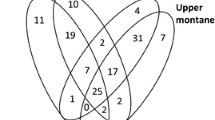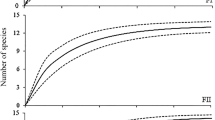Abstract
We related pteridophytes versus tree species composition to identify surrogate measures of diversity, and complementarity of seven cloud forest fragments. Forest structure, and fern and tree composition were determined in 70 (2 × 50 m) transects. Fern density (10,150–25,080 individuals/ha) differed among sites. We recorded 83 fern species in the transects. Nonparametric richness estimators indicated that more sampling effort was needed to complete fern inventories (14 more species). However, ferns recorded outside of the transects increased richness to 103 species (six more species than predicted). Twenty-eight species were unique and rare due to special habitat requirements (Diplazium expansum, Hymenophyllum hirsutum, Melpomene leptostoma, Terpsichore asplenifolia), or were at a geographical distribution edge (Diplazium plantaginifolium, Lycopodium thyoides, Pecluma consimilis, Polypodium puberulum). Correlations between fern richness and tree richness and density were not significant, but were significant between fern richness and fern density, between epiphytic fern density and tree richness and density. Tree richness is not a good surrogate for fern diversity. Only three species were recorded in all fragments (Polypodium lepidotrichum, P. longepinnulatum, P. plebeium); thus fragments’ pteridophytes compositions are highly complementary, but more similar for ferns than for trees. A regional conservation approach which includes many small reserves needs to focus supplementarity on patterns of tree and fern species richness.
Similar content being viewed by others

References
Anderson R.S. and Ashe J.S. 2000. Leaf litter inhabiting beetles as surrogates for establishing priorities for conservation of selected tropical montane cloud forests in Honduras, Central America (Coleoptera; Staphylinidae, Curculionidae). Biodiversity and Conservation 9: 617–653.
Bernabe N., Williams-Linera G. and Palacios-Rios M. 1999. Tree ferns in the interior and at the edge of a Mexican cloud forest remnant: spore germination and sporophyte survival and establishment. Biotropica 31: 83–88.
Bigelow S. and Kukle P. 2000. Ferns. In: Nadkarni N.M. and Wheelwright N.T. (eds) Monteverde. Ecology and Conservation of a Tropical Cloud Forest. Oxford University Press Inc., New York, p. 89.
Brose U. 2002. Estimating species richness of pitfall catches by non-parametric estimators. Pedobiologia 46: 101–107.
Challenger A. 1998. Utilización y Conservación de los Ecosistemas Terrestres de México. Pasado, Presente y Futuro. Comisión Nacional para el Conocimiento y Uso de la Biodiversidad. UNAM, Agrupación Sierra Madre, S.C, México, D.F.
Chazdon R.L., Colwell R.K., Denslow J.S. and Guariguata M.R. 1998. Statistical methods for estimating species richness of woody regeneration in primary and secondary rain forests of northeastern Costa Rica. In: Dallmeier F. and Comiskey J.A. (eds) Forest Biodiversity Research, Monitoring and Modelling. The Parthenon Publishing Group, Paris, France, pp. 285–309.
Churchill S.T., Balslev H., Forero E. and Luteyn J.L. 1995. Biodiversity and conservation of neotropical montane forests. Proceedings of the Neotropical montane forest biodiversity and conservation symposium. The New York Botanical Garden, 21–26 June 1993. New York Botanical Garden, New York.
ColwellR.K. 1997. EstimateS: statistical estimation of species richness and shared species from samples. Version 5. User’s guide and application published at: http://viceroy.eeb.uconn.edu/estimates
Colwell R.K. and Coddington J.A. 1994. Estimating terrestrial biodiversity through extrapolation. Philosophical Transactions of the Royal Society (Series B) 345: 101–118.
Dirkse G.M. and Martakis G.F.P. 1998. Species density of phanerogams and bryophytes in Dutch forests. Biodiversity and Conservation 7: 147–157.
Gaston K.J. 1996. Biodiversity. A Biology of Numbers and Difference. Blackwell Science Ltd., Cambridge, UK.
Grubb P.J. 1977. Control of forest growth and distribution on wet tropical mountains: with special reference to mineral nutrition. Annual Review of Ecology and Systematics 8: 83–107.
Haber W.A. 2000. Plants and vegetation. In: Nadkarni N.M. and Wheelwright N.T. (eds) Monteverde, Ecology and Conservation of a Tropical Cloud Forest. Oxford University Press Inc., New York, pp. 39–69.
Hartshorn G.S. and Hammel B.E. 1994. Vegetation types and floristic patterns. In: McDade L.A., Bawa K.S., Hespenheide H.A. and Hartshorn G.S. (eds) La Selva, Ecology and Natural History of a Neotropical Rain Forest. The University of Chicago Press, Chicago, Illinois, pp. 73–89.
Hietz P. and Briones O. 1998. Correlation between water relations and within-canopy distribution of epiphytic ferns in a Mexican cloud forest. Oecologia 114: 305–316.
Hietz P. and Hietz-Seifert U. 1995. Composition and ecology of vascular epiphyte communities along an altitudinal gradient in central Veracruz, Mexico. Journal of Vegetation Science 6: 487–498.
Howard P.C., Viskanic P., Davenport T.R.B., Kigenyi F.W., Baltzer M. and Dickinson C.J. 1998. Complementarity and the use of indicator groups for reserve selection in Uganda. Nature 394: 472–475.
Kappelle M. and Gómez L.D. 1992. Distribution and diversity of montane pteridophytes of the Chirripó National Park, Costa Rica. Brenesia 37: 67–77.
Margules C.R., Pressey R.L. and Williams P.H. 2002. Representing biodiversity: data and procedures for identifying priority areas for conservation. Journal of Biosciences 27: 309–326.
Negi H.R. and Gadgil M. 2002. Cross-taxon surrogacy of biodiversity in the Indian Garhwal Himalaya. Biological Conservation 105: 143–155.
Palacios-Rios M. 1992. Las pteridofitas del estado de Veracruz, Mexico. M.Sc. Thesis. Facultad de Ciencias, Universidad Nacional Autónoma de México, México, DF.
Palacios-Rios M. and Gómez-Pompa A. 1997. Phytogeographical analysis of the pteridophytes of Veracruz, México. In: Johns R.J. (ed) Holttum Memorial Volume. Royal Botanic Gardens, Kew, Richmond, UK, pp. 217–234.
Pausas J.G. and Sáez L. 2000. Pteridophyte richness in the NE Iberian Peninsula: biogeographic patterns. Plant Ecology 148: 195–205.
Pharo E.J., Beattie A.J. and Binns D. 1999. Vascular plant diversity as a surrogate for bryophyte and lichen diversity. Conservation Biology 13: 282–292.
Poulsen A.D. and Nielsen I.H. 1995. How many ferns are there in one hectare of tropical rain forest? American Fern Journal 85: 29–35.
Riba R. and Pérez-García B. 1997. Pteridofitas. In: González Soriano E., Dirzo R. and Vogt R.C. (eds) Historia Natural de Los Tuxtlas. UNAM-CONABIO, Mexico DF, pp. 175–181.
Rossignol J.-P. 1987. Los estudios morfoedafológicos en el área Xalapa-Coatepec, Veracruz. In: Geissert D. and Rossignol J.-P. (eds) La Morfoedafología en la Ordenación de los Paisajes Rurales. Conceptos y Primeras Aplicaciones en México. INIREB-ORSTOM, Xalapa, Veracruz, Mexico.
Rzedowski J. 1996. Análisis preliminar de la flora vascular de los bosques mesófilos de montaña de México. Acta Botánica Mexicana 35: 25–44.
SAS 1997. JMP User’s Guide. SAS Institute, Cary, North Carolina.
SEMARNAT 2002. Norma Oficial Mexicana NOM-059-ECOL-2001, Protección ambiental-Especies nativas de México de flora y fauna silvestres-Categorías de riesgo y especificaciones para su inclusión, exclusión o cambio-Lista de especies en riesgo. Diario Oficial de la Federación, 6 March, 2002, México, DF.
Sosa V. and Gómez-Pompa A. 1994. Flora de Veracruz. Lista florística. Fascículo 82. Instituto de Ecología, A.C. Xalapa, Veracruz - University of California, Riverside, California.
ter Braak C.J.F. and Smilauer P. 1998. CANOCO Reference Manual and User’s Guide to Canoco for Windows: Software for Canonical Community Ordination (version 4). Microcomputer Power, Ithaca, New York.
Tryon R. 1989. Pteridophytes. In: Lieth H. and Werger M.J.A. (eds) Ecosystems of the World 14b. Tropical Rain Forest Ecosystems. Biogeographical and Ecological Studies. Elsevier, Amsterdam, The Netherlands, pp. 327–338.
Tryon R., Voeller B., Tryon A. and Riba R. 1973. Fern biology in Mexico (a class field program). BioScience 23: 28–33.
Tuomisto H. and Poulsen A.D. 2000. Pteridophyte diversity and species composition in four Amazonian rain forests. Journal of Vegetation Science 11: 383–396.
Tuomisto H. and Ruokolainen K. 1993. Distribution of Pteridophyta and Melastomataceae along an edaphic gradient in an Amazonian rain forest. Journal of Vegetation Science 4: 25–34.
Werff H. van der 1992. Substrate preference of Lauraceae and ferns in the Iquitos area, Peru. Candollea 47: 11–20.
Whitmore T.C., Peralta R. and Brown K. 1985. Total species count in a Costa Rican rain forest. Journal of Tropical Ecology 1: 375–378.
Williams-Linera G. 2002. Tree species richness complementarity, disturbance and fragmentation in a Mexican tropical montane cloud forest. Biodiversity and Conservation 11: 1825–1843.
Williams-Linera G., Manson R.H. and Isunza E. 2002. La fragmentación del bosque mesófilo de montaña y patrones de uso del suelo en la región oeste de Xalapa, Veracruz, México. Madera y Bosques 8: 73–89.
Young K.R. and Leon B. 1989. Pteridophyte species diversity in the central Peruvian Amazon: importance of edaphic specialization. Brittonia 41: 388–395.
Young K.R. and Leon B. 1991. Diversity, ecology and distribution of high-elevation pteridophytes within Rio Abiseo National Park, North-Central Peru. Fern Gazette 14: 25–39.
Author information
Authors and Affiliations
Corresponding author
Rights and permissions
About this article
Cite this article
Williams-Linera, G., Palacios-Rios, M. & Hernández-Gómez, R. Fern richness, tree species surrogacy, and fragment complementarity in a Mexican tropical montane cloud forest. Biodivers Conserv 14, 119–133 (2005). https://doi.org/10.1007/s10531-005-4053-5
Received:
Accepted:
Issue Date:
DOI: https://doi.org/10.1007/s10531-005-4053-5



